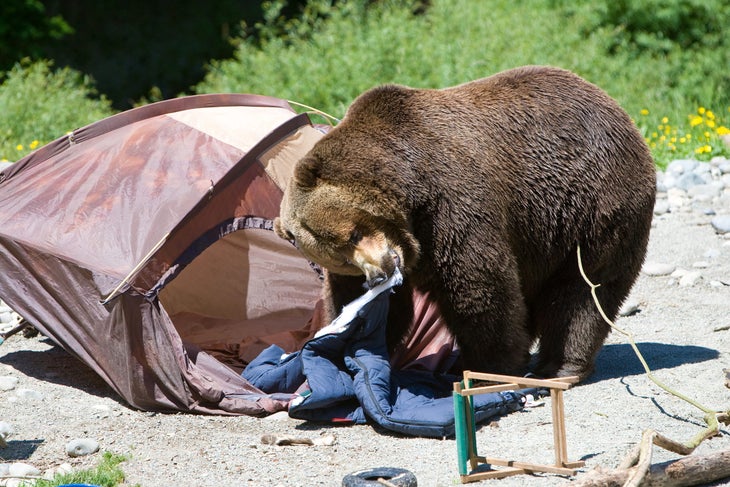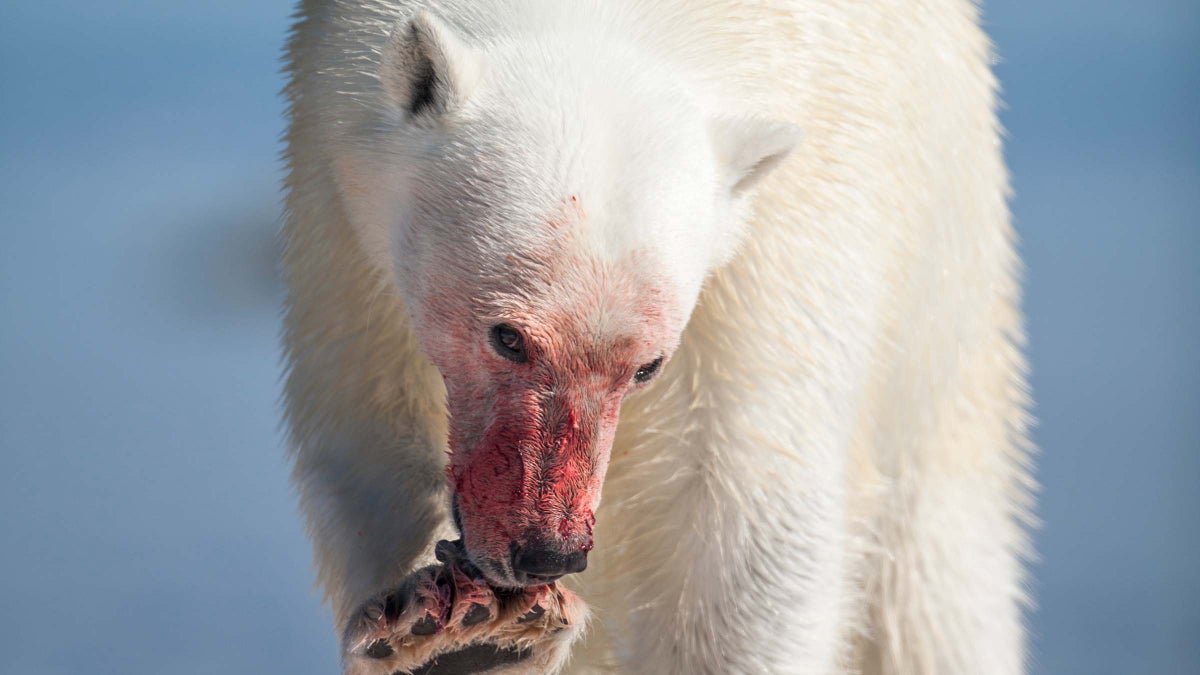Products You May Like
Get full access to Outside Learn, our online education hub featuring in-depth fitness, nutrition, and adventure courses and more than 2,000 instructional videos when you sign up for Outside+
Sign up for Outside+ today.
Pop quiz: You’re done with a perfect backcountry meal and ready for a night out under the stars when you realize your beautiful campsite has a visitor— a mama grizzly. Time seems to slow to a crawl as she swivels her head towards you and begins to close the distance. Do you:
- Back away slowly while making yourself as big as possible and talking to the bear in a firm voice
- Spritz it with the bear spray you keep in a belt holster
- Run back down the trail screaming and flailing your arms
- Grab one of her cubs and hold it hostage until she backs off
Trick question! The answer is E: Choose from one of these innovative-yet-under-appreciated techniques that our lawyers didn’t want us to publish—probably because they’re too effective. Just don’t be surprised when your hiking partners start calling you Grizzly Adams.
Use a Bear Bag to Safely Store Food, Toiletries, Scented Trash, and Yourself

Hanging a bear bag may have gone out of vogue with the advent of bear canisters, but there’s one crucial piece of food that won’t fit in those things: You. Since good bear safety never goes out of style, the next time you’re bedding down in Bear Country, go old school.
To start, find a tree limb at least as wide in diameter as your thigh that’s at least 20 feet off the ground and 6 feet from the tree’s trunk. Take the 100 or so feet of arborist-grade static line you’ve brought and weave it through the grommets along the edge of the heavy-duty tarp you carried in. Next, arrange all your food and trash in a tightly packed circle around yourself. Then, toss one end of the line over the tree limb, and tie the other end off in a slip knot around the base of the loose end. Finally, start heaving. If you’ve done everything right (and have serious upper body strength), you and your food will be safely out of harm’s way for the rest of the night. Just don’t let go of the rope.
Bring No Food Whatsoever
Even if you don’t see a single sign of bears on your hike, you will still need to store your food overnight. The easiest solution: don’t bring any. Bears can’t smell food you don’t have, and leaving all of your meals at home will save you pounds while minimizing the chance that a hungry griz heads over to your camp in search of the buffet. Sure, hiking hard for several days with exactly no calories might not be “normal” or “fun.” But bears go months at a time without eating and look how strong they are! Bonus: A loudly growling stomach is just as effective as shouting “Hey bear!” to scare bears off.
Maul the Bear Before it Mauls You

Experts recommend making lots of noise to alert bears to your presence and, if you do encounter one, backing away slowly while speaking to it in a firm but calm tone. And, sure, being calm and reasonable may get you out of one bear encounter unscathed. But what happens when all the other bears hear about what an enormous wimp you are? They’ll line up to take a bite out of you.
Better idea: On the first day you hike anywhere new, find the biggest, meanest bear around and show it who’s boss. Beat the pulp out of it while screaming “This is what you get! This is what you get!” loud enough for the entire forest to hear. (Alternatively, hit the bear with its own paws while taunting it with the phrase “Why you mauling yourself?”) Once word gets around about what a maniac you are, the other bears will give you a wide berth, as will most other hikers.
Feed the Bear So Much That it Gets Stuck in the Door of its Den
Developed by pioneering English bear safety expert A.A. Milne, this technique takes advantage of bears’ natural tendency to gorge themselves. First, find a bear den near where you intend to camp. Next, arrange a variety of delicious snacks just inside the entrance to the den including several large jars of honey. Finally wait for the bear to encounter the feast on its way out the door and watch as it helps itself to your refreshments, at first tentatively, then ravenously. When the bear has finished and attempts to leave, its now distended stomach will make it too wide to get out of its own den. Tell it you’re going to get help and hike in peace, knowing that instead of attacking you, the bear is still trapped in its own house, muttering “Oh bother” to itself and attempting to wiggle free.
Dress Up as a Bear, Adopt Their Ways, and Abandon the World of Humans
Look, we could sit here all day and tell you stuff about bears–what they like, what they don’t like, whatever. But the truth is that if you want to understand bears, you need to think like a bear. Go buy a bear costume, leave your car by the side of some nameless forest road, and walk into the woods to live among the bears. Spend your mornings flipping spawning salmon out of a river with your paws and feasting on their belly fat; snooze through your afternoons in the underbrush, huckleberry pulp smeared around your mouth. Pass a winter denned up under a log somewhere, sleeping the snow away. Live like a bear, and you’ll begin to understand how they see the world.
And who knows: maybe you’ll like it. Maybe you’ll decide you can’t go back to the world of commutes and health insurance deductibles and cable news pundits. Maybe you’ll abandon your human possessions, first your phone, then your clothes, then your name, then all that useless human language. People will wonder where you went sometimes. You won’t think about them at all. You’ll be too busy looking for the next beehive to raid. Note: The “Maul a Bear Before it Mauls You” strategy may still be necessary in this context.
